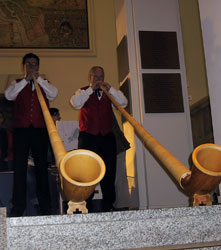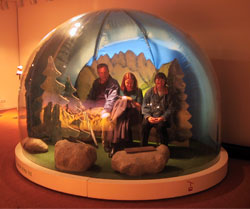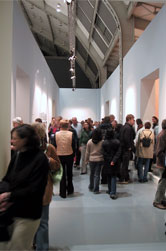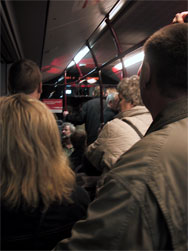Last night was die Lange Nacht der Museen -- "the long night of the museums" -- where 42 museums across Hamburg stayed open from 6 PM until 2 AM. Each museum put on an assortment of special events -- lectures, tours, food, music, dancing; six special bus lines (and a boat) ran between the various museums on 10-20 minute intervals. Being museum junkies, we had to take part!
We'll begin the story with some pictures ...
 |  |
| Alpenhorn players at the Altonaer Museum. | Shelby (and two total strangers) inside an Alpine snowglobe in the Altonaer Museum's "Heidi" exhibit. |
 |  |
| The Martin Parr exhibit at the Deichtorhallen; a little too crowded to properly appreciate the photos ... | Inside a crowded bus on its way to the Abwasser- und Sielmuseum, around 10:30 at night. |
We started the evening in our neighborhood, at the Museum für Kommunikation Hamburg, which covers the many various ways people have communicated across the miles -- post, telegraph, telephone, radio, via satellite and undersea cable, the Internet . . . they really try to cover everything, and mostly do a good job at it; I think the museum has expanded to twice the size it was when I first saw it four years ago! We browsed the exhibits, tried our hand at writing with quill pens -- their special activities centered around "postal art" and various communication games -- and then moved on.
After the Museum for Communication, we went across town to the Altonaer Museum. We were drawn by the posters they've had up around town for a special exhibit, Heidi: Mythos - Marke -Medienstar (Heidi: the Myth - the Brand - the Media Star), a retrospective about Joanna Spyri's children's book Heidi, and all the things that have grown from it over the years. I didn't realize that Heidi was such a global and lasting phenomenon; apparently there's something of a Heidi cult in Japan (she made it big there after they produced some anime films based on the story), and you can visit "Heidiland" if you go to Switzerland.
Most of the Altona Museum's special activities were Heidi-related; they had a pair of alpenhorn players, and booths giving out Swiss tourist information and samples of Swiss cheese. We had dinner at the museum's restaurant (I'm always impressed by how many interesting restaurants in Germany are shoved into unexpected, out-of-the-way places; in America, you'd be lucky if a museum that size had a cafeteria), and then moved on, resolving to come back and spend more time visiting the Altonaer Museum on a "normal" day.
Our next stop was the Deichtorhallen, a set of large halls that display international modern art and photography. The Deichtorhallen was the hub of the Lange Nacht -- all of the buses to the other museums arrived and left from there -- so it was completely packed. We walked through one of their exhibits, a retrospective on the work of Martin Parr, a British photographer, but it was far too crowded to properly appreciate the photos.
After the Deichtorhallen, it was about 10 PM and Shelby was done with museums for the night. I walked her back to the main train station and she took a U-Bahn train for home. After that, I walked back to the Deichtorhallen and caught a bus to my last objective for the night, the Abwasser- und Sielmuseum -- the Waste Water and Sewer Museum. This was the most frustrating line of all; because part of the visit included a tour through the adjacent sewage-treatment plant, they were only taking twenty visitors at a time. The line stretched down the block; I got in, and waited, and waited, without moving very far. Around 11:15 PM, I was ready to give up and call it a night -- but just as I was about to leave, a man with a cart came up to our section of the line and started handing out hard hats from the cart. I got one -- and of course, then I had to wait, because who wants to leave after they've given you a yellow plastic hardhat?
Even after the hardhat, it still took about a half hour longer to get in, but I was glad I did, because it turned out to be very interesting. For the first part of the tour, a guide took us into the museum, which consisted mostly of things found in the sewer over the past 160 years -- a collection vast enough to defy description. There were toys, jewelry, license plates, hubcaps, a pile of wallets and purses (and in another room, a wall of drivers licenses from an assortment of countries, ID cards, passports, transit passes, credit cards ... they said that when it comes to ID, they give back everything they can, but considering the source, most people must not want it back), a wide variety of womens' undergarments, tools, street signs, a few bicycles -- a real cross-section of life!
After seeing the museum of collected items, the sewage-treatment plant was almost a letdown. This part of the tour was relatively brief -- only a few rooms -- but we did get to see a section of the old sewer feeding into the plant, which looked suitably Gothic and theatrical -- big brick archways with a river of muck flowing through, the walls stained with the effluvia of years. To get to this section, we had to go through an airtight door; there were signs on the door warning of the risk of explosion and telling us to turn off all cell phones and other electrical equipment. The employee who opened the door was holding some kind of air-quality meter; I guess that it'd look bad for the sewer authority to aspyxiate twenty citizens taking a tour of the premises ...
When I got out of the sewers, it was fifteen minutes after midnight. Having had enough museums for the day (and not being hardcore enough to last until closing time at 2 AM), I walked to the nearest S-Bahn station and rode home, sharing my train with the last of the drunken revellers from the Eurovision Contest.
Posted by Kevin at May 16, 2004 10:11 PM